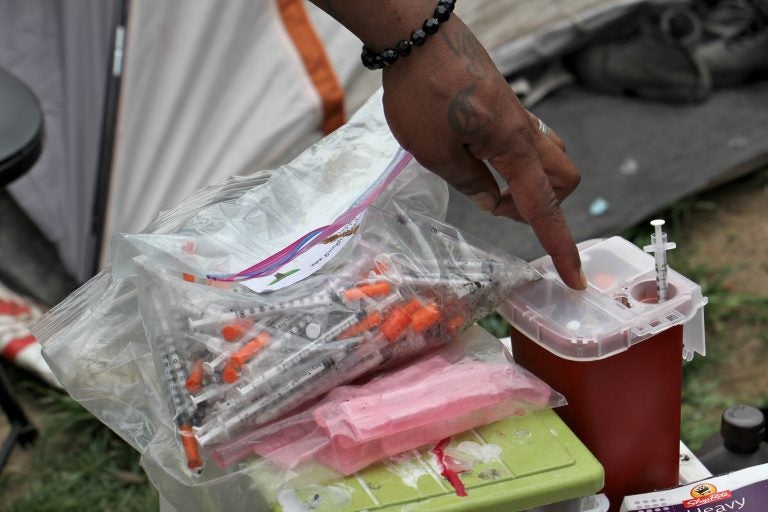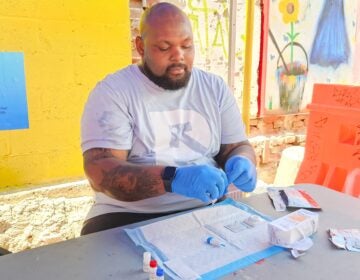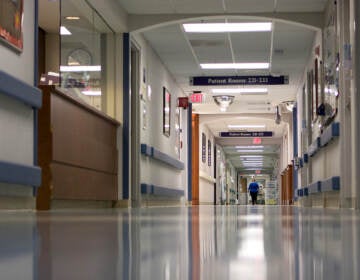N.J. to launch local needle exchanges, enhance services at current sites
The state Department of Health says the plans are part of a broad multiagency strategy to foster syringe-access programs and other offerings across New Jersey.

A resident of the Kensington Avenue encampment shows how he safely disposes of his used needles. (Emma Lee/WHYY)
This story originally appeared on NJ Spotlight.
—
While details remain scarce, New Jersey officials have pledged to launch new local needle-exchange programs and enhance services at the seven existing sites, part of their wider effort to better address opioid addiction and some of its side effects.
State Department of Health Commissioner Dr. Shereef Elnahal mentioned the plans as part of a broad, multi-agency strategy to address opioids that Gov. Phil Murphy outlined in late January during a visit to Camden. Syringe-access programs are “proven public health tools,” Elnahal said at the event; the commissioner also advocated for the idea during an NJ Spotlight roundtable last year.
The health department is now talking to “numerous” counties and municipalities about working together to create new syringe-access programs, officials said, and it hopes to beef up nursing staff, program options, and the stock of supplies at the current exchanges.
Run by local nonprofits, traditionally on a shoestring budget, these programs let intravenous-drug users exchange used, or dirty, needles for clean ones. They also provide other healthcare or social services, including referrals to drug treatment. Programs now operate in Atlantic City, Asbury Park, Camden, Jersey City, Newark, Paterson, and Trenton; in 2018 they reached nearly 3,500 users and collected more than half a million dirty needles, according to the DOH.
New Jersey’s seven existing programs share roughly $2.7 million in state and federal funds under the current budget, Murphy’s first, and the state hopes to “strengthen and expand” these initiatives in the coming year, DOH spokesperson Nicole Kirgen said. (The governor is scheduled to introduce his second annual budget proposal early next month.)
HIV down, hep-C rising
While HIV rates have declined in recent years, hepatitis-C rates have risen significantly, and as many as nine out of 10 new infections are tied to IV drug use, according to federal statistics. Hep-C can cause liver damage, cancer, and even death. State officials estimate there are 169,000 New Jerseyans who are already infected with hep-C, and many more are carrying the disease without being diagnosed.
Advocates who led the fight in Trenton to establish syringe-exchange initiatives, which began as a pilot project in 2006, welcomed the Murphy administration’s support and financial commitment. But the unmet need for these services remains huge, they said, and there exist challenges — including local opposition — to establishing new exchange sites.
A new administration, a welcome change
“It’s a different ballgame” working with a progressive administration that embraces this philosophy, which can reduce the spread of blood-borne infections like HIV and hepatitis C,” explained Axel Torres Marrero, a senior policy director with the Hyacinth AIDS Foundation. Nationwide, more than 200 programs have been established in at least three dozen states. “But we still suffer from the history of how (the New Jersey program) came to be,” Marrero said.
Former Gov. Chris Christie allocated one-time funding of $200,000 for all five then-current programs when he approved the state-wide expansion; advocates were grateful but said at the time this budget would barely cover the annual costs for one site. Scotti called it “a small amount but it still made a big difference.”
In September 2017, Christie announced he would commit another $2.1 million to the five syringe-access sites as part of $200 million he planned to allocate to various opiate-related efforts in his final months in office. But a review conducted the following year by the incoming Murphy administration found that most of these funds were never actually spent or allocated to the programs as Christie promised.
New Jersey’s effort started as a demonstration in five urban hubs, a result of a bill by Sen. Joseph Vitale, who then fought to expand the concept to additional sites. Christie eventually approved the measure to create new programs and provided some funding, but the law still requires local government officials to endorse a new initiative in their community. “Until it’s embraced at the statewide level, we’re still at the mercy of local politicians,” Marrero said.
Kirgen, with the DOH, said officials are working collaboratively with municipalities and counties to build local support for additional programs, although she declined to give any specifics. We welcome communities with an interest in having a SAP to work with us to make it a reality,” she said.
Local challenges
Passing a local ordinance is a challenge, “but it’s been getting easier,” said Roseanne Scotti, president and CEO of the state Drug Policy Alliance chapter, and longtime advocate for needle exchange. Votes to create the two most recent programs, in Asbury Park and Trenton, were unanimous, she recalled.
“I think the harder part was that there was no money” available from the state on a regular basis to support these programs, Scotti said. Despite those challenges, the initiatives have helped more than 10,000 individuals, including thousands who connected with medical testing and treatment; roughly one in four participants also started in a drug rehab program, according to the DPA.
The original five programs were forced to cobble together grants from a handful of nonprofits and foundations and often relied on donated syringes and supplies, recalled Scotti, who contributed items herself. Several programs launched online fundraising campaigns in the summer of 2016 in an effort to cover the budget gap, when Christie declined to provide new resources.
Development and real estate pressures also forced the Camden program, one of the state’s busiest, to suspend its operations later that summer; it reopened in November 2018, for a few hours twice a week, at a location outside the city center. (As a result, the Camden site assisted just 49 people last year, according to the DOH data, but still collected more than 2,000 needles.)
Murphy was the first to include funding in the annual budget, a situation advocates hope will continue in the years to come. “We’ve come a long way, and the Murphy administration has stepped up in a new and exciting way,” Scotti said.
Staff at the DOH have held regular quarterly meetings with syringe-access program leaders and coordinated best-practice training for some of those involved, Scotti said. And the funding allowed each exchange to hire a full-time dedicated staff member — a first for some programs.
While the 2018 statistics from the DOH show just over 2 percent of those engaged in the program were referred to drug treatment — and barely half those individuals were actually admitted to a program — Scotti said there could be logical reasons for this decline. For example, a treatment facility located across the street from the needle exchange in Atlantic City has moved out of town, making it more challenging for those with addictions to participate.
And the data doesn’t reflect the multitude of other ways syringe-access programs help participants, Scotti added, including wound cleaning, diabetes care, and help with other chronic conditions. It also doesn’t account for the distribution of naloxone, the overdose reversal agent, which can be helpful to many of those using needle-exchange services.
“The most important thing is they are bringing people out of the shadows and into a connection of care,” Scotti said. “The first goal (of prevention programs) is to keep people alive. Dead people don’t recover.”
WHYY is your source for fact-based, in-depth journalism and information. As a nonprofit organization, we rely on financial support from readers like you. Please give today.




